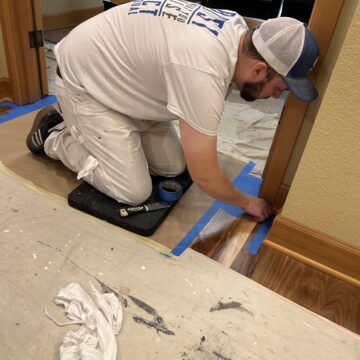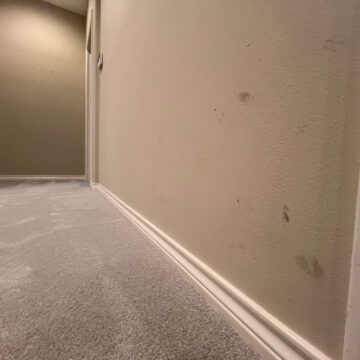Deciding whether to paint before or after installing new flooring can be a puzzle for homeowners planning home renovations. This decision can drastically alter the project’s quality, since attention to detail is crucial when installing new carpet or vinyl flooring, as it is with interior painting. Therefore, it’s important when managing a multi-faceted remodel to make an informed decision about the order of work based on your specific circumstances.
To assist with this decision, we’ve partnered with the flooring gurus at Koeber’s Interiors to combine our wisdom and share it with you.
The Short Answer
An expert painter (like us!) can be trusted to paint last; if you’re not hiring a professional with a rigorous preparation process, paint first – but you’ll have to settle for a lower quality finish in the end.


Tips from Koeber's
When it comes to carpet installation, Koeber’s suggests painting the trim and walls before laying down new carpets. However, this recommendation hinges on the painter’s proficiency in safeguarding the flooring. Usually, new carpeting is the final element to be installed before moving in furniture and calling the space done. This is because inexperienced painters may not adequately shield freshly installed flooring.
For hard surfaces, it’s necessary to remove existing baseboards before installation and then repaint them neatly after reinstallation to cover nail and caulking holes.
The Pearl Painters team carefully carries out painting tasks after the installation of new floors. Being specialists in residential repainting, we possess the necessary equipment and knowledge required to work in occupied homes. Our meticulous process ensures that fresh surfaces receive the utmost care.
Our Advice: Paint Last
We share the Koeber’s team’s view that painting should happen first if the painter cannot ensure the new carpet’s protection, or if they lack experience. However, when dealing with laminate or hardwood floors, painting beforehand is ill-advised, no matter who the painter is.
Unlike painters who prioritize their own convenience, Pearl Painters emphasizes thorough protection of both new flooring and furniture, thereby reducing reliance on touch-ups later on.
Some painters will underestimate the time and cost of what become very necessary touch-ups, resulting in higher expenses for the customer. Such contractors may boast about their speed and cost savings from skipping the extensive preparation required when new floors are in place. Unfortunately, they often overlook the additional work required after carpet, hardwood, or vinyl flooring installation. Suddenly, scheduling all that follow-up work becomes a challenge.
It’s also important to note that touch-ups often fall short of perfection as they generally don’t blend seamlessly. This is especially true for baseboards, which are the most likely to be damaged during floor installation or refinishing. If you want perfectly glossy, evenly painted baseboards, then you need to have us paint them after the flooring is complete.
While we appreciate that correcting imperfections is a necessary part of the painting process, we emphasize preparation and care upfront in order to reduce dependency on fixing issues later on.



Residential Repainters vs New Construction Painters
New construction painters, more accustomed to working in unfinished rooms, lack experience in safeguarding carpet. They usually arrive before the carpet is laid in a new home. With hard flooring, they can come in after installation since messes are easier to clean up.
However, it’s this lack of experience that puts them behind residential repainting specialists like our Pearl Painters team. We have a process and the necessary equipment and expertise to fully protect flooring and furniture in order to minimize disruption to your home. We’re used to working in occupied homes, and we prioritize protection as a fundamental aspect of our workflow. We employ specific methods to safeguard and isolate surfaces during painting.
For a flawless and consistent finish, it’s critical to hire the right painter after completing your flooring installation.
Communication Is Key
When a painter arrives at a home prepared to start work, only to discover that flooring installation is scheduled shortly after, it can create significant challenges. That’s why we always inquire about any planned remodeling work before finalizing our schedule.
Efficient coordination among contractors is crucial during a remodel to ensure seamless progress. Ideally, contractors should collaborate to schedule work effectively in order to avoid delays or unexpected repair work.
Lack of communication, or a painter starting work before flooring installation, leads to inevitable touch-ups. This results in increased costs as painters must spend extra time rectifying damage caused during the demo and installation of new flooring.
At Pearl Painters, our focus for touch-ups is on refining details like correcting crooked lines, as opposed to fixing damage caused by inadequate preparation.


The Risks of Painting First
Installing flooring after painting will result in necessary touch-ups afterward, regardless of the flooring type. The extent of damage varies based on the floor material and installation. Since fresh paint requires 30 days to fully cure, installing flooring within this timeframe significantly increases the likelihood of damaging the paint.
Installing Carpet After Painting
Due to the rough backs of carpets, damage to freshly painted baseboards is inevitable. There are soft-backed carpets, which does reduce damage, but you will still have touch-ups. No matter the carpet back roughness, there are other factors, including pounding the carpet under the baseboards for tack strip installation.
Installing Vinyl Flooring After Painting
Luxury Vinyl Plank (LVP) installation can also lead to damage to baseboards and walls, necessitating touch-ups. Transitioning from carpet to LVP typically involves removing and reinstalling baseboards, allowing painters to repaint them effectively. Pearl Painters always enjoys partnering with Koeber’s on a project because of their meticulous approach to baseboard removal, minimizing the need for extensive repairs during painting and streamlining the overall process.
An Ace Up Our Sleeve
We have a special technique to avoid using tape on new vinyl or hardwood floors that might leave unwanted marks. Instead, here’s how we use playing cards:
To reinstall the baseboards, we start by laying down paper followed by a playing card, then the baseboard. This process is repeated several times until all baseboards are in place. This method prevents paint from bleeding onto the floor. When the work is complete and it’s time to remove the paper, it can be easily slid out due to the presence of the playing cards.
This particular method would only happen if the flooring contractor knew that the painters were coming in afterward, so collaboration between contractors who share an awareness of the project schedule can have great results.



A Note on Hardwood Refinishing
When working with a hardwood refinishing specialist, they should state in their contract that baseboards will need to be touched up afterward. This is especially true if they are stripping the color and restaining, since the stain can walk up the tape and stain the baseboards.
Fortunately, we know exactly how to handle painting in a room with newly refinished – even restained – hardwood floors. Baseboards are typically not removed during hardwood floor refinishing, so it’s key to protect them properly during the process and even more crucial to paint afterward without harming your gorgeous new floor.
We have all the materials, including special 3M tape, plus the experience needed to give you both beautiful floors and paint – without any compromise.
Opting for a professional residential repainting service ensures a superior finish for your renovation, particularly when painting after installing new flooring. With Pearl Painters, you can rest assured that your floors will be taken care of so that your project can stay on track!


